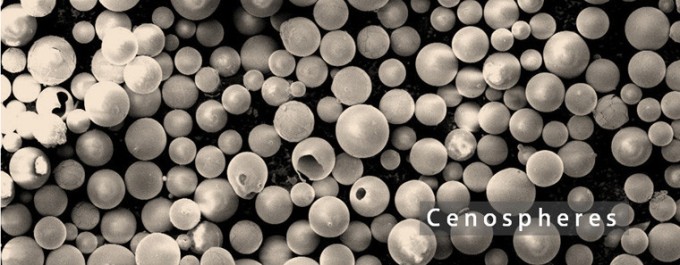Like
fly ash, cenospheres are naturally occurring by-products of the burning
process at coal-fired power plants. Unlike fly ash though, cenospheres
are lightweight, inert, hollow spheres comprised largely of silica and
alumina and filled with air and/or gases. Since they are inert, they are
not considered a pozzolan. And because they are very small and have
high compressive strengths, cenospheres can be used as structural
lightweight filler.
Cenosphere from India has some general properties:
- Chemical Properties:
- Silica: 48% – 74%
- Alumina: 26% – 45%
- Iron: 1.5% – 4.00%
2 Physical Properties:
- Size: 75-400 microns
- Bulk Density: 0.20-0.25 grams per cubic centimeter (g/cc)
- Specific Gravity: <0.4 g/cc
- Compressive Strength: ~90% survival @ 2500psi
- Softening Point: 1040 degrees C
- Color: Light tan
Cenosphere from India
can be studied through Chemical engineering. The progress of the
Cenosphere Enhancement and Optimization Project is an initiative that
seeks to improve existing methods of cenosphere extraction. Cenosphere
is primarily used to create lightweight cement. It is also a good filler
for polymers and its benefits are well-noted, particularly in the
construction industry. Cement made with cenosphere is much lighter and
this eases the burden shouldered by construction workers on a daily
basis.
How cenosphere from India are produced?
Cenospheres
are produced in very large amount in thermal power plants. They are
always looked upon as fillers used to reduce the density and cost of the
polymer. If cenosphere particles are allowed to remain properly
dispersed by taking it in lower concentration, significant improvement
in its mechanical, thermal, electrical, crystallinity, colorimetric and
morphological properties are expected. To make it happen,
epoxy/cenosphere composites were prepared, having lower concentration of
cenosphere. Concentration of cenosphere in epoxy, cured with
triethylenetetramine, was changed as 0, 3, 5, 7 and 10. Tensile
Strength, Tensile Modulus, Percentage Elongation at Break and
Crystallinity decreased, whereas, Flexural Strength and Flexural Modulus
were found to have increased by 50% and above 100% respectively at 7
phr loading of cenosphere in epoxy. Thermal and electrical stability
also increased with increase in concentration of cenosphere in the
epoxy; however, the samples became blackish with increased addition of
cenosphere. Using SEM analysis it was found that, cenospheres were
properly and uniformly dispersed at 7 phr concentration and formed
aggregates at 10 phr concentration.

No comments:
Post a Comment